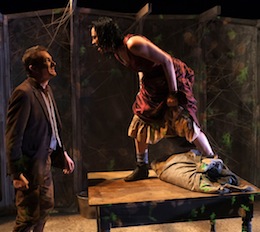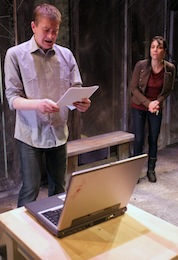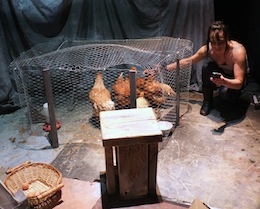Why aren't more double-headers written? It seems a sensible response theatrically to the allegedly rapid shrinkage in our attention span as a species, in an era dominated by soundbite, tweet and gnomic social media postings. The one-act has its difficulties, however. How do you distil a satisfyingly paced, substantial drama into an hour or so? How do you make three-dimensional, convincingly motivated characters in approximately half the time a full-length piece of writing gives you?
These problems aren't fully overcome in Mary Kelly’s Nora's Story, the first of two plays yoked together under the collective title The Scarlet WWWeb, Portstewart company Big Telly’s latest production. The action is based on the story of the last witch to be burnt at the stake in Ireland, at the tail-end of the nineteenth century, mixing in elements of the contemporaneous socio-political situation, with references to Captain Boycott and Land League agitation.
 Nora’s story is essentially a simple one of dreams dashed and ambitions thwarted. She wants to flee the constrictedness of rural Ireland, while husband Donal, though initially supportive, becomes involved in spearheading local resistance to landlordism and is nominated for mayor of the (unspecified) locality. A third character, Peggy, stirs the cauldron of their simmering domestic differences, mischievously peddling village gossip and wittering balefully about “the little people” in the hills where Nora is prone to wander.
Nora’s story is essentially a simple one of dreams dashed and ambitions thwarted. She wants to flee the constrictedness of rural Ireland, while husband Donal, though initially supportive, becomes involved in spearheading local resistance to landlordism and is nominated for mayor of the (unspecified) locality. A third character, Peggy, stirs the cauldron of their simmering domestic differences, mischievously peddling village gossip and wittering balefully about “the little people” in the hills where Nora is prone to wander.
Donal eventually snaps, enraged by Nora’s refusal to support his civic aspirations. He beats her, pulls her hair, and concludes she is no longer the person that she used to be. Ergo, she is possessed by fairies, is a witch, and must be immolated. The final scene shows her carbonising, in a clever trompe l’oeil effect using leaping, flame-lick projections.
Why does Donal make that decision? What thought processes lead to it? What nexus of superstition and cultural belief-systems informs and shapes it? These questions are unexamined as the action hurtles melodramatically to a conclusion, leaving a contemporary audience bemused and unenlightened about what has happened. It’s like The Crucible without analysis, an opportunity missed to examine a gruesomely fascinating phenomenon (burning people) that until relatively recent times still happened on this island.
Shelley Atkinson’s wild, garrulously liquor-sodden Peggy is an object lesson in how to quickly communicate the essence of a character within the intrinsic limitations of the one-act format: it’s a funny, nuanced and extremely vivid personation. Vincent Higgins' Donal and Clare McKenna’s Nora seem a little flat and undeveloped by comparison.
 Both actors look more fully engaged after the interval in Briana Corrigan’s Martha’s Story. The setting this time is contemporary, focusing on Pete, an over-worked advertising executive who de-stresses by jabbing feverishly at his Xbox, and wife Martha, who, starved of attention, gravitates to online dalliances with Jean-Paul, ostensibly a sophisticated Parisian.
Both actors look more fully engaged after the interval in Briana Corrigan’s Martha’s Story. The setting this time is contemporary, focusing on Pete, an over-worked advertising executive who de-stresses by jabbing feverishly at his Xbox, and wife Martha, who, starved of attention, gravitates to online dalliances with Jean-Paul, ostensibly a sophisticated Parisian.
Corrigan skilfully utilises a succession of cross-cut scenes, many extremely brief, to suggest the flickering, insubstantial nature of the couple’s modus communicandi, compared to the near-obsessiveness of their internal preoccupations. There’s also clever use of a voice-mic on McKenna, sharpening focus on those lines where Martha harks fondly back to happier, romantic times with her husband, and flirts mentally with images of Jean-Paul, symbol of escape from her drab, quotidian reality.
She’s in a fantasy-world, of course, as is the equivalent character in Nora’s Story, with her thwarted dreams of a new life in America. Jean-Paul turns up, and turns out to be a Kildare farmer. Pete flips, and Martha fulminates when she discovers he has purloined her new painting for his latest, career-saving advertising feature. Everything is broken, probably never to be fixed again. Be careful what you wish for, beware of dreaming, stick to reality, appear to be the salutary messages of both the plays presented.
Like Shelley Atkinson in Nora’s Story, Keith Singleton does a sterling job in rapidly establishing the parameters of the Jean-Paul character, suggesting his creepiness, but also the loneliness and isolation of an ultimately harmless individual who craves affection. Claire McKenna’s Martha craves it too, and is particularly affecting when recalling moments of past tenderness, now all but banished in the mutely dysfunctional emotional environment she inhabits with her husband. Zoë Seaton’s direction is crisply focused, making a virtue of the fast-edit structure of the writing, which could easily seem gimmicky and disjointed.
Crucially, playwright Briana Corrigan leaves enough room in Martha’s Story for a properly motivated dénouement to organically develop: there’s no sense of rush here at the conclusion, no sense of cramming in the plot-line as the curtain beckons. You’re left pondering the situation of all three characters, wondering how they ever got to where they got to, wanting information about their futures. That’s quite an achievement for a play lasting only fifty minutes.
 There’s some slick work also on the technical front: the dozens of lighting cues in Martha’s Story are seamlessly effected, and both Higgins and McKenna negotiate the complicated blocking shifts with deft assurance. A single set, resembling a huge upended dining-table, top legs protruding outwards towards the audience, serves both plays, with shifts of furniture signalling the switch in epochs.
There’s some slick work also on the technical front: the dozens of lighting cues in Martha’s Story are seamlessly effected, and both Higgins and McKenna negotiate the complicated blocking shifts with deft assurance. A single set, resembling a huge upended dining-table, top legs protruding outwards towards the audience, serves both plays, with shifts of furniture signalling the switch in epochs.
Behind the front-stage is a second area, where Nora is incinerated, Martha paints, and a cageful of plump live chickens peck away contentedly, occasionally adding impromptu sound-effects of their own to the action. They look, at times, thoroughly befuddled. Who wouldn’t be, by the hopelessly tangled web being spun by the emotionally conflicted human beings that they see before them?
Terry Blain